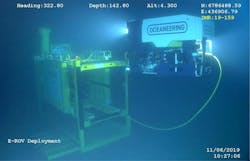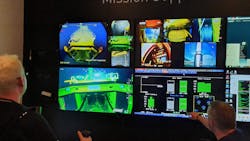‘Empowered’ ROV provides reliable remote monitoring option
Arve Iversen, Oceaneering
The industry has been calling for more innovative solutions for subsea work scopes to help reduce or eliminate carbon footprints and increase worker safety. In these uncertain times with fluctuating oil prices, now more than ever, remote operations can have a huge impact on how business is conducted, even when that business is taking place offshore, with unpredictable weather windows and harsh currents.
Reliable offshore satellite and cellular communications have made subsea resident vehicle systems possible. These vehicles can stay subsea for longer with increased battery life and without need of a support vessel. Oceaneering has worked to advance these underwater robots, and recently deployed its subsea resident vehicle, the Liberty E-ROV, for a major North Sea operator.
The Liberty E-ROV (Empowered ROV) is a self-contained, battery-powered, work-class vehicle that can carry out inspection, maintenance, and repair (IMR), commissioning, and underwater intervention activities. It is an all-in-one deployable and recoverable system.
The vehicle has a cage-mounted battery pack and tether management system, as well as a communications buoy, which hosts an antenna mast to improve signal reception and battery power to support communications transfer. Both the cage and the E-ROV are optimized to handle peak power consumption. Subsea residency, via current battery life, is designed for two to three months, but work to extend this is ongoing.
The ROV system can be controlled from Oceaneering’s Onshore Remote Operations Centers with communication provided via high bandwidth low latency 4G LTE and satellite communication from the buoy. The combination of these technologies makes the system a cost-effective subsea tool. The vehicle can be placed subsea by a vessel of opportunity equipped with a subsea-crane. Relocating the system, including for recharging of a fully depleted battery, can be done in 12 hours or less.
In early 2020, as a major North Sea operator prepared for first oil, they wanted to ensure that operations went to plan and there were no unplanned incidences during start-up through the riser. In order to maintain the highest level of oversight, the operator adopted a comprehensive pipeline seabed-to-platform monitoring plan. Oceaneering was contracted to provide the Liberty E-ROV system to complete monitoring at depths up to 310 m (1,017 ft) several times a day over the course of one to two months, dependent on findings.
The operator needed to maintain constant monitoring but ruled out using a conventional ROV system deployed from the platform or a vessel. A conventional system would have been vulnerable to stoppage during inclement weather windows and would require extensive effort for multiple deployment and recoveries across the monitoring window. If an additional vessel was required, this would have added cost and generated a significant carbon footprint. Leveraging the E-ROV enabled the operator to benefit from a field-proven, flexible solution.
Because the location of the work scope was fixed on a platform area, the vehicle was deployed in a tethered configuration. To accomplish its first tethered use, the vehicle was reconfigured before being mobilized and a charging unit was installed onboard the platform to facilitate trickle charging of the E-ROV. A dedicated control umbilical provided power and data communications connectivity directly from the platform to the E-ROV system. This solution was identified as optimal as it completely eliminated the need to recharge the vehicle’s batteries and also negated the risk associated with winter storms in the area pushing the radio buoy out of location.
The vehicle was mobilized from Forus, Norway, and deployed to the seafloor adjacent to the operator’s platform in the North Sea in February 2020. Monitoring of the riser started immediately and was conducted three to four times daily through March until April 2020. The ROV was piloted using Oceaneering Remote Piloting and Control Technology (RPACT) and all video and images were uploaded to our cloud-based Oceaneering Media Vault.
After start-up monitoring, the E-ROV was used to perform required annual subsea inspection activities before being recovered. In total, the Liberty E-ROV completed 822 hours of monitoring spread over 110 top-to-bottom trips conducted across 34 days. The vehicle did not need to dock in the subsea garage for changing or data transfer and did not require maintenance.
The months-long monitoring did not detect any issues that would have affected production commencement on the platform. The project provided the operator with assurance that operations were started successfully.
The vehicle had already been field-proven across more traditional ROV operations, but this project scope enabled the vehicle to demonstrate its capability over longer, continuous deployments. It enabled the operator to benefit not only from peace of mind, but also a more economical, efficient and emissions-friendly approach to ROV monitoring.
In terms of environmental impact, the Liberty E-ROV system was recognized in September 2020 by the National Ocean Industries Association’s Safety in Seas Safety Practice Award for its ability to reduce carbon footprint and decrease HSE risks to offshore workers. To date, the use of the vehicle has led to a 75% reduction in topside support vessel and crew support, as well as an estimated reduction of 6,000 tons of CO2 emissions.




